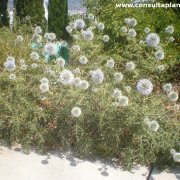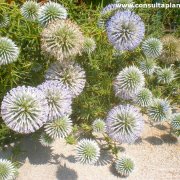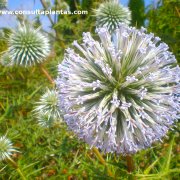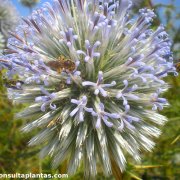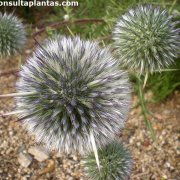Care of the plant Echinops spinosissimus or Echinops creticus |
|
The genus Echinops, family Asteraceae, comprises 200 species of annual and perennial herbaceous plants native to Eastern Europe, Central Asia, and Africa. Some species are: Echinops spinosissimus, Echinops ritro, Echinops adenocaulos, Echinops exaltatus, Echinops niveus, Echinops sphaerocephalus. Scientific synonyms: Echinops creticus, Echinops viscosus, Echinops spinosus. This species is native to southeastern Europe, northern Africa, and southwest Asia. They are erect-growing branched herbaceous plants that reach 5 meters (16.4 feet) in height. They have spiny, pinnatifid, tomentose, dark green leaves. The bluish flowers appear in very attractive globose heads. They bloom in spring. Echinops creticus is used to form impenetrable barriers, groups and massifs, in rockeries and to cover arid and dry areas of the garden. It's also used as cut flowers for bouquets and floral decorations. Echinops spinosissimus needs full sun exposure and a hot, dry climate. It tolerates frosts down to -15 ºC (5 ºF). The soil can be a garden substrate with 25% coarse sand to drain well; it can be grown in poor, sandy, stony or well-drained calcareous soils. Water moderately, waiting for the substrate to dry completely. It has high resistance to drought. Echinops viscosus does not need fertilizers. Prune withered flowers. Echinops spinosissimus is a plant resistant to the usual pests but sensitive to excessive watering that can rot the roots. Echinops creticuy propagates by seeds sown in spring or by division in late winter or fall. |
Images of the plant Echinops spinosissimus or Echinops creticus |
Find plants
Echinops spinosissimus or Echinops creticus | Care and Growing
© 2025 FavThemes
